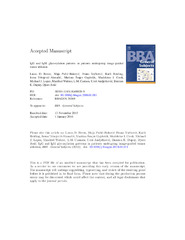Приказ основних података о документу
IgG and IgM glycosylation patterns in patients undergoing image-guided tumor ablation
| dc.creator | Breen, L.D. | |
| dc.creator | Pučić-Baković, M | |
| dc.creator | Vučković, F. | |
| dc.creator | Reiding, K. | |
| dc.creator | Trbojević-Akmačić, I. | |
| dc.creator | Srajer-Gajdošik, M. | |
| dc.creator | Cook, M.I. | |
| dc.creator | Lopez, M.J. | |
| dc.creator | Wuhrer, M. | |
| dc.creator | Camara, L.M. | |
| dc.creator | Anđelković, Uroš | |
| dc.creator | Dupuy, D.E. | |
| dc.creator | Josić, Djuro | |
| dc.date.accessioned | 2023-11-28T16:25:19Z | |
| dc.date.available | 2017-01-29 | |
| dc.date.issued | 2016 | |
| dc.identifier.issn | 0304-4165 | |
| dc.identifier.uri | https://cer.ihtm.bg.ac.rs/handle/123456789/6914 | |
| dc.description.abstract | Background Image-guided tumor ablation is a technique whereby needle-like applicators are placed directly into solid tumors under guidance typically with computed tomography or ultrasound. Changes in IgG and IgM antibody glycosylation were studied during ablation-induced immune response to cancer, and the use of glycosylation as a biomarker for diagnosis, prognosis and disease treatment was examined. Methods Plasma from 27 tumor patients was collected immediately before, after and for 6 months following ablation. IgG and IgM antibodies were isolated by use high-throughput chromatography, and analyzed by hydrophilic liquid chromatography. Thorough identification of glycan structures in each chromatography peak was performed by nano-liquid chromatography electrospray ionization mass spectrometry. Results Although antibody glycosylation was found to vary with cancer type, discernable patterns of change based on the successful treatment of tumors by ablation were not identified. One patient with renal clear cell carcinoma and poor disease outcome had unexpectedly high amount of oligomannose IgG glycans during the whole period of monitoring. In contrast, IgM antibodies did not follow the same pattern. Conclusions These findings suggest that glycosylation patterns are indicative of an immune system that is unable to prevent different types of cancer, rather than products of the immunostimulatory response to the ablation of tumor itself. Analyses of the outcome effect suggested that IgG glycosylation and IgM glycosylation are not associated with tumor ablation. General significance Present work opens a new way for parallel determination of glycosylation changes of both IgG and IgM antibodies by use of high-throughput methods, and their future use as biomarkers for disease diagnosis and prognosis. This article is part of a Special Issue entitled "Glycans in personalised medicine" Guest Editor: Professor Gordan Lauc. | sr |
| dc.language.iso | en | sr |
| dc.publisher | Elsevier | sr |
| dc.rights | embargoedAccess | sr |
| dc.rights.uri | https://creativecommons.org/licenses/by-nc-nd/4.0/ | |
| dc.source | Biochimica et Biophysica Acta: General Subjects | sr |
| dc.subject | Tumor ablation | sr |
| dc.subject | IgG | sr |
| dc.subject | IgM | sr |
| dc.subject | glycosylation | sr |
| dc.title | IgG and IgM glycosylation patterns in patients undergoing image-guided tumor ablation | sr |
| dc.type | article | sr |
| dc.rights.license | BY-NC-ND | sr |
| dc.citation.volume | 1860 | |
| dc.citation.issue | 8 | |
| dc.citation.spage | 1786 | |
| dc.citation.epage | 1794 | |
| dc.citation.rank | M21 | |
| dc.description.other | This is accepted version of the article: [https://doi.org/10.1016/j.bbagen.2016.01.011] | sr |
| dc.identifier.pmid | 26827872 | |
| dc.identifier.doi | 10.1016/j.bbagen.2016.01.011 | |
| dc.identifier.fulltext | http://cer.ihtm.bg.ac.rs/bitstream/id/28157/breen2016.pdf | |
| dc.identifier.scopus | 2-s2.0-84973609177 | |
| dc.type.version | acceptedVersion | sr |


